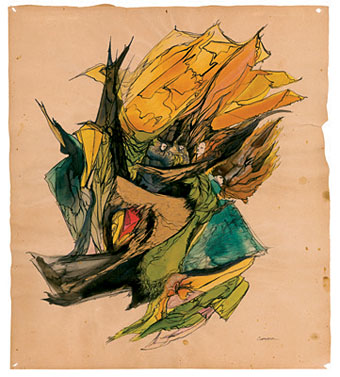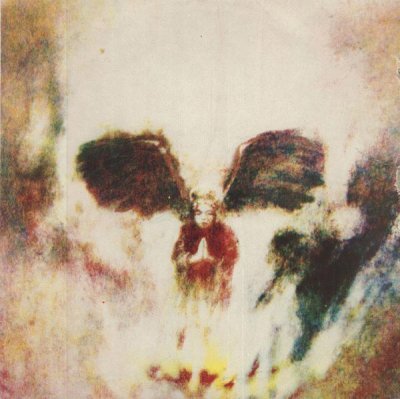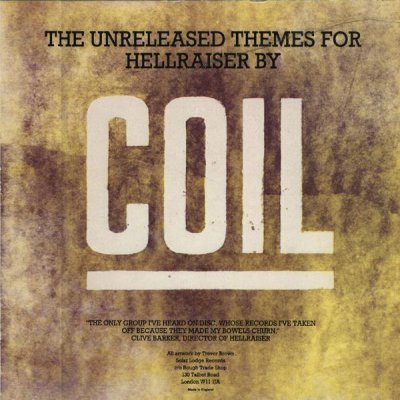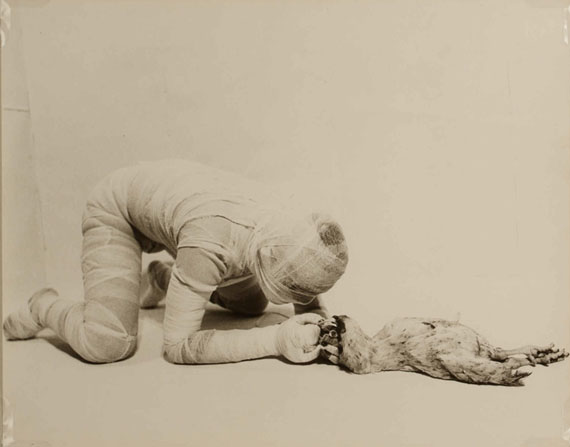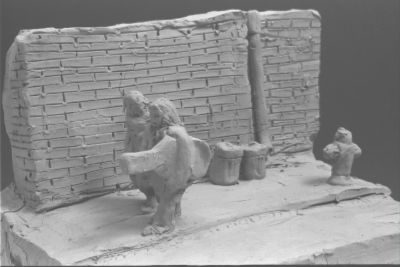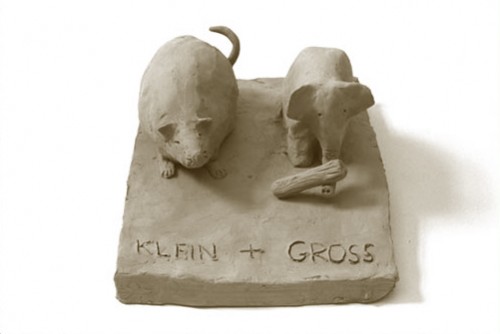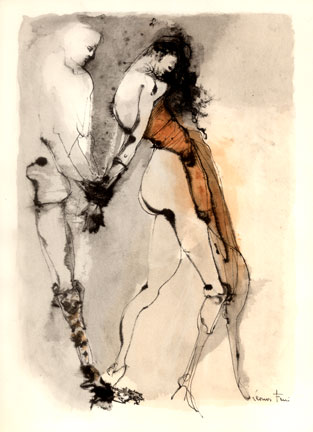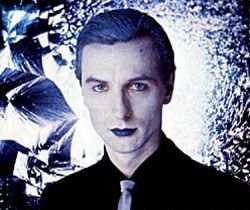From: Inauguration of the Pleasure Dome, 1954
Marjorie Cameron Parsons Kimmel (23 April 1922 – 24 June 1995) was an artist, occultist, actress, and wife of rocket pioneer and occultist Jack Parsons. Cameron played a major role in the 1946 Babalon Working ritual.
Like many women interested in magic, such as Ithell Colquhoun, Vali Myers, Rosaleen Norton and the surrealist Leonora Carrington, Cameron was also an artist. Her art depicts many images of an otherworldly nature drawn from the Elemental Kingdom and the astral plane.
She played a prominent role in Kenneth Anger's film Inauguration of the Pleasure Dome, again as the Scarlet Woman. She also appeared in two films of Curtis Harrington, his ten-minute 1956 portrait, The Wormwood Star, which focused on Cameron and her artwork, and Night Tide (1961), where Cameron starred as a mysterious woman credited as 'Water Witch'.
http://en.wikipedia.org/wiki/Marjorie_Cameron
Fairy Queen, 1962
Cameron's romantic esthetic and commanding persona prompted filmmaker
Curtis Harrington to commemorate her output as a visual artist in The Wormwood Star
(1955), a lyrical short film recording the art and atmosphere of her
candlelit studio. Most of the beautiful paintings and drawings
documented in this film were later lost or destroyed. Paul Mathison and
the actor Samson DeBrier introduced Cameron to film maker Kenneth Anger,
who cast her in a leading role opposite Anais Nin in his film Inauguration of the Pleasure Dome
(1956), a fanciful depiction of an occult initiation rite as envisioned
by Aleister Crowley. With fiery red hair and heavy eye makeup, Cameron
played the Scarlet Woman wrapped in a Spanish shawl once belonging to
Rudolph Valentine. Her striking presence steals the show from the rival
Nin. Cameron enjoyed a tempestuous relationship with Anger for the rest
of her life. She also played a key role alongside Dennis Hopper in
Harrington's lyrical feature film Night Tide (1961). In 1969 she appeared in an unreleased film filmed in Santa Fe, Thumbsuck, by artist John Chamberlain.
Michael Duncan
http://cameron-parsons.org/cameron.html
Marjorie Cameron was born in a small town in Iowa. She joined the
Navy in World War Two, drawing maps for the Joint Chiefs of Staff. After
the war she worked as a fashion illustrator at a Pasadena newspaper.
She gladly traded her Navy uniform for her interpretation of Dior's "New
Look." Her marriage to Jack Parsons gave her the opportunity to travel
to Europe and Mexico further refining "her look," always having her own
unique sense of style. Following Jack's untimely death in 1952 Kenneth
Anger made her the Scarlet Woman in "Inauguration of the Pleasure Dome,"
and Curtis Harrington made her the consummate Beat artist/poetess in
"Wormwood Star. He later cast her as a mysterious witch in Night Tide,
a role that she lived out in Hollywood. Long red hair, black dresses,
black fingernail polish... driving about town in her own hearse!
Cameron went from being a beautiful woman to crone almost overnight.
Legend had it that she traded her beauty for power. More likely, she
lost her looks as a side-effect of chain-smoking and the desert sun. She
had a hard life, and magic(k) didn't make it any easier.
Cameron was a true feminist. The loss of her physical "beauty" was
just another phase of her life as a woman. She simply did not care. She
scoffed at women who tried to hold on to their youth. I remember her
telling a friend who had some "work" done: "You can erase the lines but
the pain is still there!"
The Cameron I knew from the mid '80s till her death in 1995 was still
a beauty, but not in the sense of our youth-driven culture. Cameron's
life was her art... the way that she created magic, not only in her
incredible paintings and poetry, but in the expressive way she lived.
Scott Hobbs
http://www.huffingtonpost.com/scott-hobbs/cinderella-of-the-wastela_b_2730500.html
Marjorie Cameron
(1922-1995) was a “witchy woman” and Beatnik artist known widely in
several overlapping Los Angeles bohemian circles, but she was hardly
famous. Since her death, there has been a gradually growing public
awareness of Cameron’s art, or at least what’s left of her work, that
the artist herself did not destroy in a moment of mental instability.
Her paintings, now highly sought after by collectors, can sell for in
the tens of thousands of dollars. In recent memory, her work has been
exhibited in major museums (The Whitney’s “Beat Culture” show and the
the excellent “Semina Culture: Wallace Berman and His Circle” exhibit)
and the Nicole Klagsbrun Gallery in NYC published a gorgeous monograph of her work in 2007.
Cameron’s often wobbly orbit in life saw her cross paths with
significant cultural players like underground filmmaker Kennth Anger,
who cast her as “The Scarlet Woman” (typecasting!) in his 1956 film, Inauguration of the Pleasure Dome,
which also featured author Anais Nin. (Anger was Cameron’s roommate at
several points over the decades they knew one another). She was
certainly a part of Wallace Berman’s intimates and co-starred in. Night Tide a low-budget horror film with Dennis Hopper (who recounts a brief period of sexual intimacy with the older woman).
Richard Metzger
http://dangerousminds.net/comments/marjorie_cameron_the_wormwood_star
A couple of cartoonish ghosts descend a flight of stairs. On the
floor some vermicelli-shaped objects are arranged to resemble chains,
broken bones and skulls. Facing the ghosts, on top of the wall, a bat
spreads its wings. Together with another 200 or so unfired clay
figurines and sculptures, this work, entitled Im Keller (In the Cellar),
is part of Plötzlich diese Ubersicht (Suddenly this Overview), an
installation from 1981 that was the earliest major collaborative project
between Peter Fischli and David Weiss. This was the first time the work
has been shown since, which made the exhibition pretty significant. One
hundred and thirty-five of the original pieces were included, set on
plain white pedestals.
Strolling among the work you could encounter characters from comic
books and popular culture (Clark Kent, Max and Moritz), famous Swiss
products such as Cervelas (a fat, short pinkish wurst), biblical scenes
(The Parting of the Red Sea, Saint Francis Preaching to the Animals), or
events of earth-shattering significance (the conception of Albert
Einstein, the Italy vs Germany World Cup Final). Some of the works have
straightforward, descriptive titles: a piece of crystal, for example, is
entitled Rock Crystal, and a Christ on the Cross is just that. But then
you might come across a sculpture of a man riding a motorbike entitled
Dr Hoffman after the First LSD Trip. Insanely wide-ranging and
permanently incomplete, Suddenly this Overview is a leisurely and
hilarious catalogue of scenes created from memory. There is a magical
and almost hallucinatory quality to such a proliferation of
particularities. Looking from label to sculpture to check if what you
read was really what you got, you could sense how much fun the artists
must have had making the work.
This playfulness is where the installation’s subversive force lies:
working in unfired clay, a technique you would normally use for
preliminary studies in traditional sculpture, Fischli and Weiss found a
form of process art that steered clear of both Expressionist pretensions
and Conceptual taxonomies, stressing the idea of two people managing to
joke together and still being able to call that ‘work’.

